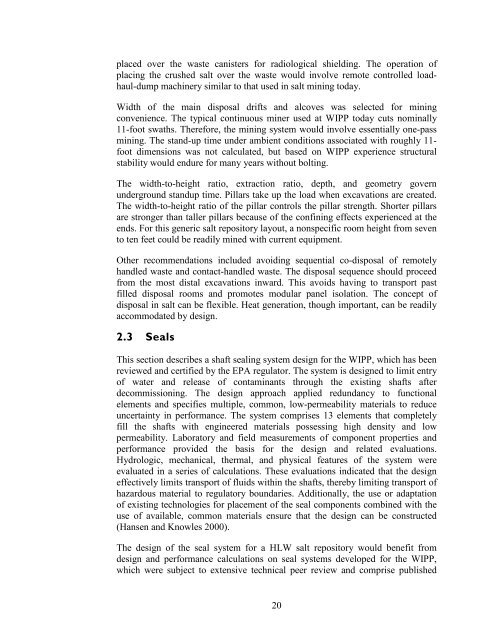Salt Disposal of Heat-Generating Nuclear Waste
Salt Disposal of Heat-Generating Nuclear Waste
Salt Disposal of Heat-Generating Nuclear Waste
You also want an ePaper? Increase the reach of your titles
YUMPU automatically turns print PDFs into web optimized ePapers that Google loves.
placed over the waste canisters for radiological shielding. The operation <strong>of</strong><br />
placing the crushed salt over the waste would involve remote controlled loadhaul-dump<br />
machinery similar to that used in salt mining today.<br />
Width <strong>of</strong> the main disposal drifts and alcoves was selected for mining<br />
convenience. The typical continuous miner used at WIPP today cuts nominally<br />
11-foot swaths. Therefore, the mining system would involve essentially one-pass<br />
mining. The stand-up time under ambient conditions associated with roughly 11-<br />
foot dimensions was not calculated, but based on WIPP experience structural<br />
stability would endure for many years without bolting.<br />
The width-to-height ratio, extraction ratio, depth, and geometry govern<br />
underground standup time. Pillars take up the load when excavations are created.<br />
The width-to-height ratio <strong>of</strong> the pillar controls the pillar strength. Shorter pillars<br />
are stronger than taller pillars because <strong>of</strong> the confining effects experienced at the<br />
ends. For this generic salt repository layout, a nonspecific room height from seven<br />
to ten feet could be readily mined with current equipment.<br />
Other recommendations included avoiding sequential co-disposal <strong>of</strong> remotely<br />
handled waste and contact-handled waste. The disposal sequence should proceed<br />
from the most distal excavations inward. This avoids having to transport past<br />
filled disposal rooms and promotes modular panel isolation. The concept <strong>of</strong><br />
disposal in salt can be flexible. <strong>Heat</strong> generation, though important, can be readily<br />
accommodated by design.<br />
2.3 Seals<br />
This section describes a shaft sealing system design for the WIPP, which has been<br />
reviewed and certified by the EPA regulator. The system is designed to limit entry<br />
<strong>of</strong> water and release <strong>of</strong> contaminants through the existing shafts after<br />
decommissioning. The design approach applied redundancy to functional<br />
elements and specifies multiple, common, low-permeability materials to reduce<br />
uncertainty in performance. The system comprises 13 elements that completely<br />
fill the shafts with engineered materials possessing high density and low<br />
permeability. Laboratory and field measurements <strong>of</strong> component properties and<br />
performance provided the basis for the design and related evaluations.<br />
Hydrologic, mechanical, thermal, and physical features <strong>of</strong> the system were<br />
evaluated in a series <strong>of</strong> calculations. These evaluations indicated that the design<br />
effectively limits transport <strong>of</strong> fluids within the shafts, thereby limiting transport <strong>of</strong><br />
hazardous material to regulatory boundaries. Additionally, the use or adaptation<br />
<strong>of</strong> existing technologies for placement <strong>of</strong> the seal components combined with the<br />
use <strong>of</strong> available, common materials ensure that the design can be constructed<br />
(Hansen and Knowles 2000).<br />
The design <strong>of</strong> the seal system for a HLW salt repository would benefit from<br />
design and performance calculations on seal systems developed for the WIPP,<br />
which were subject to extensive technical peer review and comprise published<br />
20
















